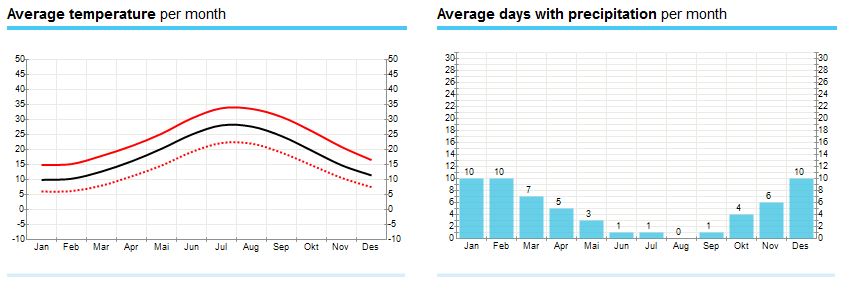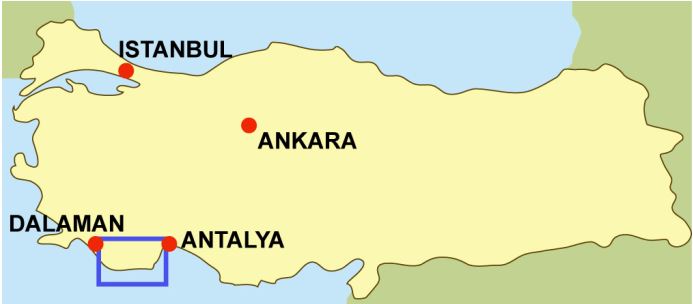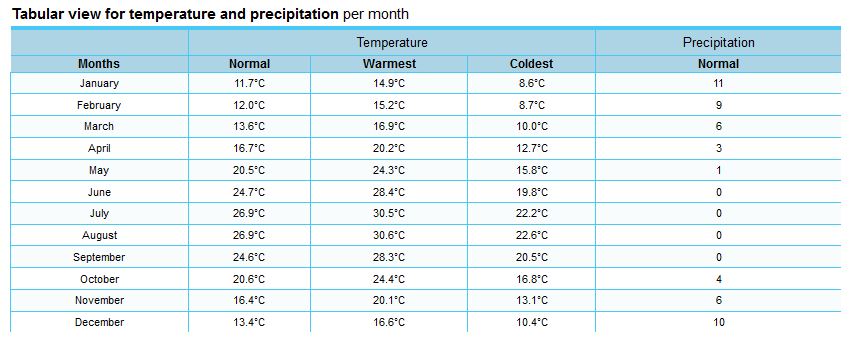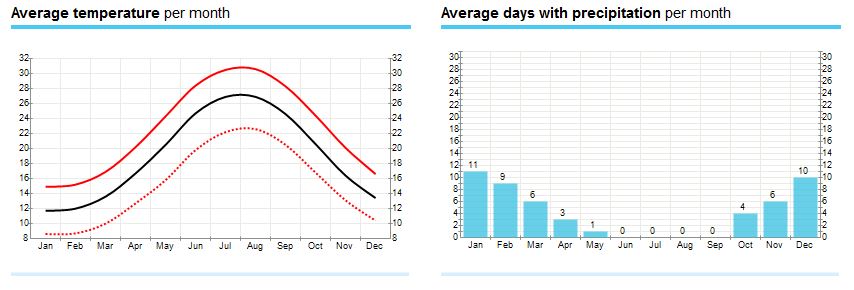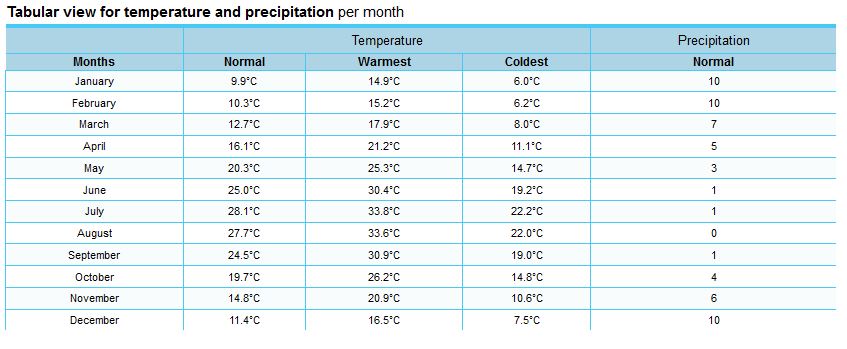Vacation Spots
Kas is the last county town located on the south-west cost of Antalya. Antiquity name of Kas was Antiphellos (facing Phellos). As written on ancient sources; Antiphellos means “the extension of Phellos on sea” or the “coast of Phellos (stony place)”. Antiphellos is now a village located on the north of Kas and called Cukurbag.
Average Weather in Kaş
Hot season / summer is in June, July, August .
Most rainfall (rainy season) is seen in January, February, October and November.
Kas has dry periods in April, May, June and July.
On average, the warmest month is July.
On average, the coolest month is January.
November is the wettest month.
June is the driest month.
Climate of Turkey
Surrounded by high mountains and open seas, Turkey is a cornucopia of natural wonders. Apart from that, Turkey is noted for its climatic diversity ranging from the Mediterranean to oceanic to continental climates.
The northern regions of Turkey have an oceanic climate whereas the southern areas are affected by a temperate Mediterranean climate. The continental climate reigning in the internal regions makes one experience four seasons in one day.
The southern regions which are popular among tourists particularly in summer and the central and northern regions of Turkey which are in demand rather in winter are popular for their cultural heritage as well as the variety of touristic and sports facilities.
Subject to a variety of climates, Anatolia is also rich in flora and fauna. The habitat of numerous varieties of flora and fauna alongside magnificent forests, Turkey, is worth visiting any season of the year.

One of the greatest cultural legacies of the Turks who played a major role in the beginning and development of the history of civilization and undertook the first great migration bringing along their values and culture to the Anatolian lands is the Turkish cuisine.
The Turkish cuisine, which had originated from the blending of the Asian, European, Middle Eastern and African cultures and evolved under the influence of the Seljuk and Ottoman Cuisines over the centuries, offers thousands of various dishes and delicacies.
Turkish cuisine evolved long before the Common Era, during the times of hunting and gathering. To provide the hunters with delicious and savory food the women of the time developed various dishes by trial and error and discovered the spices that added flavor.

Lycia’s History - A Struggle For Freedom
The history of Lycia is a story of fierce struggles against those who sought to invade and dominate it, as it was a very desirable region. It appears that Greek efforts to colonize Lycia during the first millennium B.C. were largely unsuccessful even though there were several Athenian expeditions.
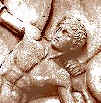 |
The first recorded instance of Lycian resistance fighting occurred around 540 BC when the Persians under the commander Harpagos overran all Asia Minor during the rule of Cyrus II (The Great). The Persians attacked the Lycian capital city of Xanthos and the Xanthosians put up a heroic fight. In the end however, they chose mass suicide over surrender. The men of Xanthos gathered their wives, children and possessions in the acropolis and set fire to all before rushing out fighting to die to the last man. Herodotus of Halicarnassos reports: |
"The Persian Army entered the plain of Xanthos under the command of Harpagos, and did battle with the Xanthians. The Xanthians fought with small numbers against the superior Persians forces, with legendary bravery. They resisted the endless Persian forces with great courage, but were finally beaten, their womenfolk, children, slaves and treasures into the fortress. This was then set on fire from, below and around the walls , until destroyed by conflagration. Then the warriors of Xanthos made their final attack on the Persians, their voices raised in calls of war, until every last man from Xanthos was killed."
Shopping in Kaş
The Lycian way is a 509 km way-marked footpath around the coast of Lycia in southern Turkey, from Fethiye to Antalya. The Lycian Way is a coastal walk and mild temperatures mean it can be walked throughout the winter months.
According to the Sunday Times the Lycian Way is one of the ten most beautiful long distance hikes of the world.

| Kaputaş Beach One can reach this beach from Kas via the scenic Kalkan road by 20 minutes drive. There is a long stair way down to this sandy beach with white-crested waves and magnetizing turquoise color sea.There are no facilities in the beach and the open secret about the stunning turquoise color is the snow-white pepples covering the sea floor. |
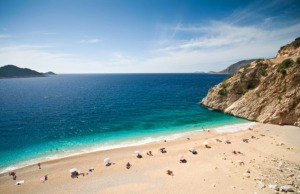 |
| Blue Cave The Cave was first discovered in year 1972. It is one of the most famous anchoring points of tour boats around Kas, with a 50 m length, 40 m width and 15 m height. It was a habitation for the seals in the past. Because of the narrow entrance the sunlight fogged in through the sea creating joyfull lighting effects and reflections inside the cave walls and ceiling, It is very close to Kaputas Beach and only 18 km to Kas. |
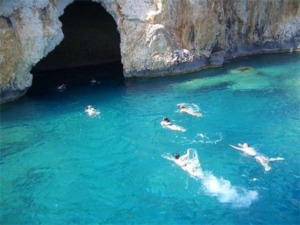 |
CIRALI resort of Kemer, of Antalya catches people's attention with "sun, sea and natural beauties" as well as the historical richness. At South end of the city lies the ancient city of Olympus, and in the north west there is the Yanartas (Chimera).
The pearl of Antalya, Cirali's coastline is 3.2 km in length. And its width ranges between 50 to 100 meters. The beach rises in a gentle slope from the sea. On both ends it is limited with rocks. Cirali's coastline is made of generally fine-grained structured high-quality sand. At South end through the ancient city of Olympus, a stream passes and merges with the sea.
With your private car:
Drive from Antalya towards the Kumluca-Kas direction turn left on the sign for Cirali 7 km after Tekirova.
With Bus
You may take either the Cicek tour or Antalya tour buses traveling from Antalya intercity bus station to the direction of Kumluca Kas and get off at crossroads of Cirali. You can come to Cirali taking the Shared Taxis there.
By Plane
Come to the intercity bus station of Antalya from the airport and then you can come Cirali by Cicek tour (Çiçek Tur) or Antalya tour busses.
Cirali region has a Mediterranean climate. Summer rain is quite rare rains, the weather is usually open, clear and sunny.
Sea water is heated and can swim towards the end of April until November.

There serves seaside restaurants, pergolas, fast-food type garden cafés at the Olympus coast and in the town center of Cirali .
People who eat In Ulupinar may attaste grilled food , appetizers and salads, pancakes and melon ice cream.
Ones who may have the picnic possibility consume the foods left in the cold water that has soon gained the natural coldness.
Beach restaurant in the center of Olympos and Çıralı coast localities, gazebos, garden cafes serving fast-food type.
Great seafood restaurant in Cirali, cucumber, squid stew stew, meats, olive oil, pancakes, kebabs, pizzas you can eat your appetite.

You may the explore the lost city walking along a different route each day from Cirali which is in the center of East Lycian walking ways or you may swim in the sea in deserted small bays.
You can have breakfast with completely natural foods, under the orange and pine trees. Also by renting a car daily you may travel to Phaselis - Arycanda - Myra in the near vicinity or you can go to the sunken city Kekova.

In order to drive to Olympos from Antalya-Finike road it should be turned at Ulupinar where there is the sign plate for ruins.
A narrow but the exquisite beautiful road leads us right to the beach of Olympos. In order to reach the ruins one should cross the brook and walk a while on the beach then the brook banks are came across of which runs through Olympos.
The path that runs along the brook will lead us into the ruins.
Olympos reOlympos region is located on the coastline of Cirali that is 3.2 km-long. The ancient city of Olympus is located just behind the coastline. There are tree houses and accommodation facilities within walking distance to the region.
A small peaceful Mediterranean resort and fishing town on the beautiful Turquoise Coast of Turkey, Kalkan has not been touched by mass tourism. More sophisticated than the usual resort town, Kalkan appeals to travelers looking for more than a “sun and sea” holiday. According to the Sunday Times, Kalkan attracts the kind of visitor who would also enjoy Tuscany or the Dordogne. The Guardian likens the town to “the Italian Riviera minus the poseurs.”
Because of its great charm, Kalkan has a growing number of perennial visitors who say the town is the only holiday destination they would choose to visit repeatedly. There is simply no other town quite like Kalkan along Turkey’s coast.
"Mouse" and "Snake" Islands in Kalkan Bay
Kalkan curls snuggly around a historic harbour sheltered at the foot of the towering Taurus Mountains. (Read more about the geography of the region at our Lycia website here) The town overlooks a beautiful bay in which islands seem to magically float upon the shimmering sea.
Narrow streets twist down to the harbour, lined with old whitewashed villas with shuttered windows situated alongside small local specialty shops and restaurants in historic buildings. Overhead hang original carved Ottoman Greek timber balconies garlanded with thick masses of brilliantly coloured bougainvillea cascading to the streets below. It is a very special place with a unique atmosphere.
How to reach Kalkan

Food & Cuisine Kalakan

Sightseeing in Kalkan

History of Kalkan
About Patara
How to reach Patara
Klima & Temperaturen Patara

Food & Cuisine Patara

Sightseeing in Patara

History of Patara
About Kekova
How to reach Kekova

Food & Cuisine Kekova

Sightseeing in Kekova

History of Kekova
Subcategories
Kaş Article Count: 7
Olympos/Çıralı Article Count: 6
Kalkan Article Count: 6
Patara Article Count: 6
Kekova Article Count: 6
Demre/Hoyran Article Count: 6
Demre/Hoyran



